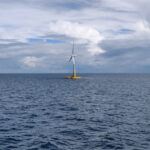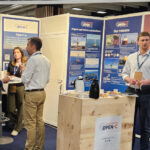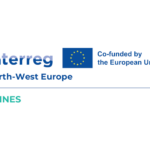 HiPoTeSis approved by Interreg Atlantic Area: strengthening floating offshore wind test infrastructure across Europe
HiPoTeSis approved by Interreg Atlantic Area: strengthening floating offshore wind test infrastructure across Europe

Lhyfe, one of the world’s pioneers in green and renewable hydrogen production, has announced that its offshore hydrogen production pilot, known as Sealhyfe, was successfully towed 20 kilometres out into the Atlantic and connected with the SEM-REV power hub, the Centrale Nantes offshore test site, operated by the OPEN-C Foundation. As of 20 June 2023, the platform began producing its first kilos of offshore hydrogen, marking a decisive milestone for the future of the sector.
Sealhyfe: Designed to meet unprecedented challenges
In launching the world’s first offshore hydrogen production pilot, Lhyfe wanted to prove the technical feasibility of such a project and acquire the operational experience needed to quickly scale up.
The company therefore voluntarily chose to confront Sealhyfe with the toughest conditions. It will be tested under real conditions, on a floating platform, which has been re-engineered to stabilise the production unit at sea (the WAVEGEM platform, engineered by GEPS Techno), and connected to Central Nantes’ SEM-REV offshore testing hub operated by the OPEN-C Foundation, which is already linked with a floating wine turbine (FLOATGEN, engineered and operated by BW Ideol).
For this, Lhyfe and its partners designed, built and assembled all of the technology necessary for producing hydrogen offshore, including the 1 MW electrolyser supplied by Plug, in just 16 months. The Sealhyfe platform, which is less than 200 sq. metres in area, is capable of producing up to 400 kilograms of hydrogen a day.
Eight months of trials at quay to “derisk” this world first
From September 2022 to May 2023, Sealhyfe was moored at the Quai des Frégates, in the Port of Saint-Nazaire. Lhyfe and its partners have thus been able to draw knowledge from a series of start-up tests in order to approach the second phase of the project with confidence, and get the most out of the trials. Tests included:
- Benchmarking tests: Hundreds of tests were carried out at quay recording the precise behaviour and performance of the platform, so that they can be compared with the Phase 2 trial results via the thousands of sensors installed on the platform.
- Technology and system optimisation: All of the technology has been adapted to operate offshore in extreme conditions and designed to minimise the number of maintenance interventions required at sea. The tests performed at quay allowed Lhyfe to further optimise and approve the technology’s behaviour.
- Development of key solutions: Lhyfe also developed the software and algorithm building blocks necessary to manage the site remotely. It will operate fully autonomously, more than 20 kilometres off the coast and in connection with the SEM-REV testing site’s subsea hub.
Following this first phase, Lhyfe has already updated its specifications for all its sites – on and offshore – so that they can apply this valuable expertise. All Lhyfe units will therefore benefit from the state-of-the-art operating optimisations trialled under this experiment.
Start of offshore production: Millions of data to collect
Sealhyfe was towed this 19 May to the SEM-REV offshore testing site, 20 kilometres off the coast of Le Croisic (France). It was then connected to the site’s subsea hub via a dedicated umbilical cable that was specially designed for the hydrogen application. The system was restarted and on stream in just 48 hours.
Lhyfe will now reproduce all of the tests carried out at quay several times in order to have a strict comparison of results and will then tackle additional offshore-specific tests. In achieving the reliable offshore production of hydrogen in an isolated environment, the company will develop a unique operating capability which involves managing the platform’s movement and environmental stresses, and validating green and renewable hydrogen production software and algorithms.


